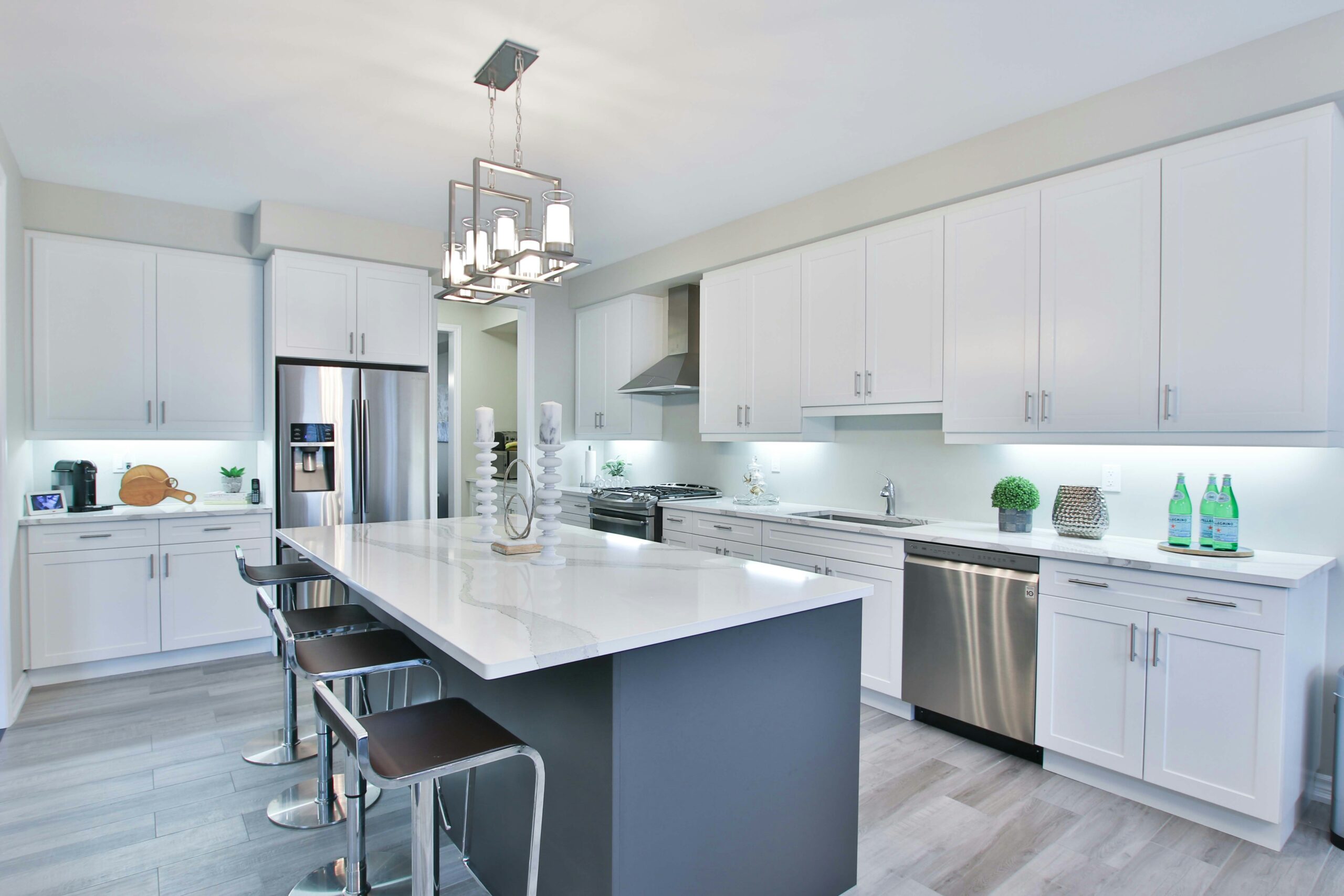Remodeling a kitchen in an old house is about revitalizing the core of your house. This journey requires a delicate balance — respecting the original architecture while infusing it with contemporary functionality and style.
Decide What the End Goal Is
Remodeling a kitchen in an older home can be exciting and intimidating. Whether you’re a do-it-yourself enthusiast or intend to hire a kitchen designer, the first step is to determine your end goal. Your plan will inform every choice you make, from the layout to the degree of remodeling.
Start by imagining how your kitchen will ultimately feel and appear. Are you going for a completely modern makeover, or are you hoping to keep some of the old house character while adding some modern appliances?
Consider the amount of light, workflow, prep space efficiency, and how the kitchen’s design will blend in with the rest of your house. For instance, you can keep the original architectural features, such as a pantry, but open up the area for a more modern kitchen.
Choose the areas in your kitchen where you can afford to save, and others where you can splurge without sacrificing the space’s overall quality and functionality.
Remember that your ultimate goal is to create a new kitchen that complements your needs and lifestyle.
Kitchen Remodel on a Budget
Renovation of an old kitchen doesn’t have to be that expensive. You can revamp your kitchen without going over budget if you plan and use a little imagination. This method is especially good for people who like DIY projects or want to keep most of the original charm of their old houses.
The secret to a budget-friendly kitchen redesign is determining which features can be updated rather than replaced. For example, painting old cabinets or changing the countertops and backsplash can significantly alter the kitchen’s appearance. This concept is similar to the method used in many do-it-yourself home repair tales, where minor adjustments result in big improvements.
Painted Cabinets and Walls
Go through magazines and websites with DIY tips and tricks to get new ideas for the color schemes, materials, and furniture you can use. You’ll see that changing the color scheme of your walls and cabinets breathes new life into old spaces. Just adding a new trim can open the space up and give it a new look. And with proper cleaning and priming, you can even repaint the fridge door.
Color coordination can balance new and old components by keeping the kitchen’s original charm while adding a modern touch. All-white kitchens and natural color schemes, including shades of green, brown, and neutrals, never go out of style.
Kitchen Back Wall
The back wall requires special consideration when remodeling the kitchen of an older home. Repainting the rear wall is a simple and affordable approach to give the area a new look, especially if you’re on a tight budget or want to make a small adjustment. But in a lot of old kitchens, the original back wall tiles have worn down so much that they no longer add to the overall charm.
Although repainting is an option, getting the complete tile work done both on the floor and the walls is generally a more effective strategy.
Selecting the correct tiles is essential. Choose tiles that go well with the color palette and other aspects already present in the kitchen. Pick timeless patterns that complement the home’s historical aesthetics to make sure the new tiles complement the kitchen. Alternatively, modern tiles can give the room a modern twist by creating a dramatic contrast.
In addition to improving the appearance of the walls, installing new tiles offers the chance to update other features like insulation or drywall, which may be very helpful in older homes. This useful yet sometimes disregarded feature not only makes the kitchen look better, but it also makes it more functional and energy-efficient. It’s a chance to look for any hidden problems, such as structural flaws hidden by tiles and cabinets or water damage behind the sink, and take care of them before they get worse.
New Lights
Any kitchen’s atmosphere may be greatly altered by its lighting, but it’s especially important in old dark homes where the lighting is frequently dingy and outdated and kitchens lack windows. Replacing outdated light fixtures with new ones should also be guided by practicality — lighting up the surfaces where you prep and cook.
Contemporary light fixtures can make a big statement by strikingly contrasting the more traditional features. Think about modern touches combined with architectural styles that accentuate your home’s historical details.
Light strips below the counters can create a warm atmosphere, and a faux window lit from behind can create the illusion of openness in a room without enough outdoor-facing doors or windows. Pendant lights over the island can provide both functional lighting and visual appeal. These contemporary additions can greatly improve the kitchen’s ambiance and make it a more welcoming and functional area.
Making the transition to LED bulbs can be a wise decision. Compared to conventional lights, LEDs provide a more energy-efficient option. They also come in a range of color temperatures, so you may create the mood and atmosphere you want.
Upgrades to your kitchen’s lighting can also affect how colors and textures are viewed. Your newly painted cabinet or new tiles can really stand out with brighter lighting that brings out the craftsmanship.
Replace Knobs and Pulls
When it comes to a kitchen redesign, the little things frequently have the biggest impact. Changes as small as replacing outdated pulls and knobs on doors and cabinets may make a big difference in the way your kitchen feels and looks. This straightforward improvement is a quick, low-cost method to give your kitchen a better look without sacrificing its charm.
The knobs and pulls should complement the overall design. Classic designs in materials like brass or copper lend a touch of elegance to an old-fashioned kitchen and go well with the wood used on the floor, doors, or cabinets. Stainless steel or brushed nickel are examples of sleek, minimalist hardware that might provide a fresh, modern vibe.
Think about the knobs and pulls’ practicality in addition to their appearance, especially if installed on a door or a window. In the kitchen, ergonomics are important. The hardware you choose should be proportionate to the size of your cabinets and drawers and comfortable to use.
Plumbing Fixtures
Modernizing the plumbing fixtures, particularly the sink and faucets, is an important but sometimes disregarded part of renovating an old kitchen. This improvement greatly adds to the kitchen’s visual appeal and utility.
There are many options available to suit every taste and requirement when selecting a new sink. A farmhouse sink can be a great option for people who want to preserve the historical integrity of an old house because it provides enough room for kitchen duties while also paying homage to the past. However, under-mount sinks offer a smooth, clean line and come in various materials, including composite and stainless steel, if you prefer the industrial appearance.
Another place where aesthetics and practicality must come together is the choice of the faucets. With features like touchless operation and pull-down sprayers, modern faucets combine the two. Whether it’s matte black, brushed nickel, or chrome, the finish on your faucet can be a statement piece or blend in with other pieces in your kitchen.
Upgrading the plumbing is a good opportunity to evaluate and maybe replace old pipes, install new valves, or look for leaks. The long-term functionality of your kitchen depends on the plumbing, even though maintaining it may lead to additional costs.
Full Kitchen Remodel in Old House
Undertaking an in-depth kitchen renovation in an older house is a significant endeavor that frequently calls for a combination of specialist knowledge, meticulous planning, and a profound comprehension of both historical integrity and our modern needs. Working with seasoned experts can make all the difference for homeowners looking to take this on.
Enter PacWest Restoration, a business with a track record of converting historic buildings into contemporary homes while maintaining their identity. PacWest Restoration combines experience, skill, and attention to detail in each project. Our crew is prepared to handle every facet of a thorough kitchen redesign, whether it involves reconfiguring the layout, modernizing the plumbing and electrical systems, or restoring period details.
If you’re prepared to update your outdated kitchen and create a room that masterfully blends the past and current, get in touch with PacWest Restoration at:
- Email: info@pacwestrestoration.com
- Phone: +1 503-746-6545 | CCB#178343
- Address: 7409 SW Tech Center Dr, Suite 150, Tigard, OR 97223
FAQs
Can you renovate a kitchen while living in the house?
Renovating a kitchen while residing in a home is possible but it calls for careful planning and preparation. Make temporary cooking arrangements somewhere else in the house, and be prepared for some disruptions to your daily schedule. Keeping the renovation crew informed about timetables and schedules through effective communication is essential to ensuring a seamless operation.
How do you renovate an old kitchen?
When renovating an older kitchen, the goal is usually to strike a balance between adding new modern facilities and maintaining the historical elegance of the space. Examine the current structure and features that you want to keep first. Next, schedule any necessary renovations for appliances, electrical, and plumbing. While updating the kitchen for modern use, period-appropriate materials and design details can preserve the room’s historical integrity.
It might require custom cabinets, new counter space, a new sink or stove, new plumbing for the dishwasher, and extra space for a bigger fridge and microwave. Be sure to put all of your ideas on paper and consult the contractors first. For example, a new stove or oven might require some electrical work as well.
How much should you spend on a kitchen renovation?
The cost of kitchen remodeling might vary significantly depending on the materials chosen, the labor cost in your location, and the size of the project. It’s often a good idea to spend according to the value of your house. It’s generally advised to budget between 5% and 15% of your home’s worth for a kitchen renovation in order to have a fair return on investment.
What not to do when renovating a kitchen?
Do not overlook the importance of a functional plan, and it’s better to overestimate the amount of money and effort required for the remodel. Also, avoid materials that clash with your house’s general decor or are overly fashionable, as they could go out of style quickly. Additionally, avoid taking on difficult activities on your own if you lack the necessary skills, as this might result in expensive or dangerous errors.



